. . .
TUESDAY
AUGUST 7 - 2018
Langstone
Mill Pond
Peter
Milinets-Raby visited the Langstone Mill Pond this
afternoon just as the clouds moved in 1:57pm to 3pm -
low tide.
On the mud were plenty of Black-headed Gulls loafing
(150+). Amongst them were 10 Common Gulls and one
juvenile Med Gull (See photo - This is only the third
sighting of a juvenile I have had - Have Med Gulls had
a poor breeding season?
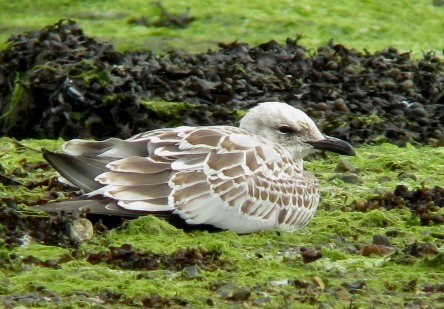
Also on the mud were:
106+ Redshank (-//B + B//LN (last seen in October
2014) & -//B + B//YO - Last seen Sept 2016). 27
Dunlin - most still with black bellies. 6 Greenshank
(G//R + BR//- - local favourite, feeds in the pond
outflow stream). 137 Black-tailed Godwits - 80% still
in summer plumage. 4 Grey Plover - all in summer
plumage. 2 Common Tern.
On the Pond: A full summer Little Grebe. 5 Little
Egrets. 9 Swallow over. 5 Swifts over heading south.
MONDAY
AUGUST 6 - 2018
Kookaburra
returns
Selena Gaunt
sent me two photos of what is clearly a Kookaburra
that she saw on Brook Meadow over the past week.
In fact, we have had
two previous sightings of a Blue-winged Kookaburra on
the meadow in early July (July 4 and 5), but none
since. It seems unlikely that there are two
Kookaburras on the loose in Emsworth, but the bird in
Selena's photos looks different from the earlier one,
less colourful and generally more scruffy. Here is the
more colourful one taken by Marion Emberson in
July.
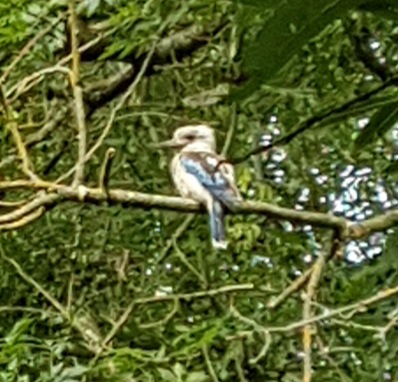
The Kookaburra is, of
course a bird Native to Australia, so will be an
escapee from a collection somewhere. Apparently, they
are quite valuable birds - costing up to £500 to
buy, so the owner would like it back, no doubt.
Terrapin
on Peter Pond
Nick Robinson
had quite a surprise yesterday when he saw a Terrapin
disappearing into the reeds on the west side of Peter
Pond. Discarded pet Terrapins do occasionally turn up
in urban ponds. I have seen them on Baffins Pond and
Petersfield Lake, but this was a first for Emsworth.
Although not unattractive, their presence in local
ponds and wetlands is generally not welcome as they
can be serious predators of native wildlife, including
fish, eggs and nestlings. I will inform David Gattrell
who manages Peter Pond of Nick's sighting. I would be
grateful for any further sightings with photos if
possible.
Here is a photo
of one taken by Mike Wells on Petersfield Lake a
couple of years ago.
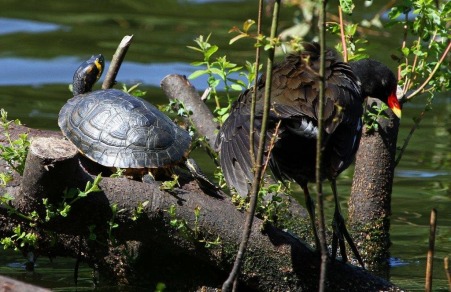
My
observations
Later this
morning I went looking for these two unusual
creatures. Very hot weather!
There was no sign of the Terrapin on Peter Pond, but
there are plenty of reeds for it to hide away in. I
thought it might like to rest on the raft in the sun,
but the Grey Heron was ruling the roost there.
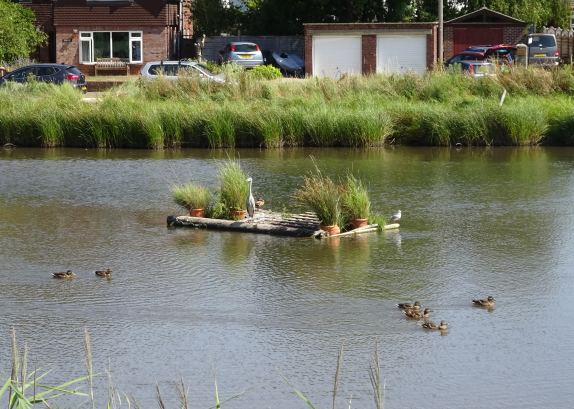
Over on Slipper
Millpond there was a flock of around 20 Canada Geese,
mostly on the rafts, with a few on the water.

There is a nice
showing of Golden Samphire on the inside of the
Hermitage bridge.
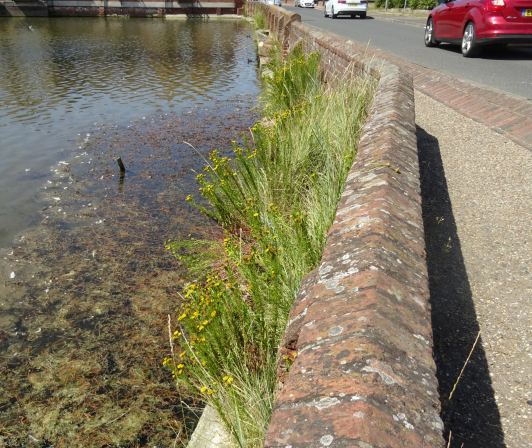
I sat for some while
in the shade on the seat on Brook Meadow where the
Kookaburra had been previously seen but there was no
sign of it.
Walking back along the riverside path through Palmer's
Road Copse I spotted a substantial hole in the east
bank of the river. It looked a bit large for a Water
Vole burrow, but you never know!
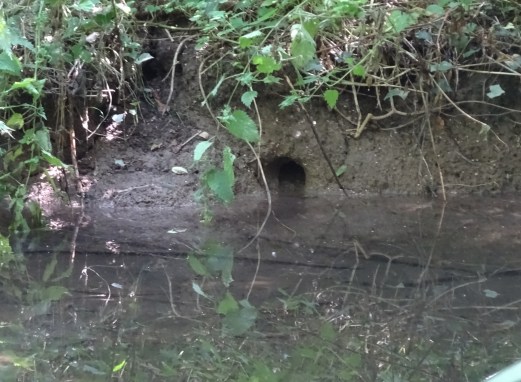
SUNDAY
AUGUST 5 - 2018
Brook
Meadow - Work session
Over to the
meadow this morning for the work session. Very hot.
Only 6 volunteers turned up. Unfortunately, Maurice
Lillie will not be able to attend work sessions for a
little while on medical advice following an
anaphylactic reaction to a wasp sting.
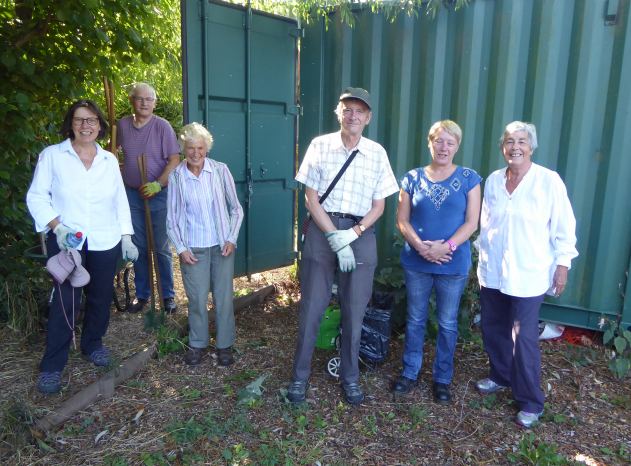
Jennifer Rye, leading,
sensibly decided to end the work session early. They
finished clearing the arisings from the orchid area
which had been cut in the previous session.

Video clip of the work
. . . . https://youtu.be/zfsEp-T5FM4
They also made a path
down to Frank's seat from the main river
path.
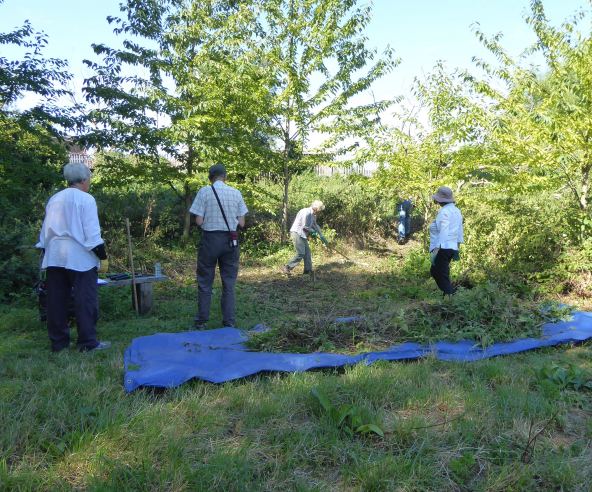
My
wildlife observations
Lots of
insects were feeding on the late flowering plants,
particularly on Hogweed. Here are a couple of
hoverflies I managed to snap which I think are
Volucella inanis and Myathropa
florea.
I was surprised to see
this Speckled Wood butterfly
feeding on the flowers of Hoary Ragwort which I do not
recall having seen before.

Finally, my first male
Common Darter of the year on Brook Meadow
resting on vegetation near the Lumley Stream, the
first of many no doubt.
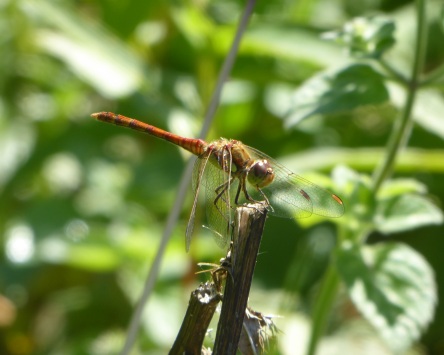
Warblington
shore
Peter
Milinets-Raby visited the Warblington shore yesterday
morning as the tide dropped from 6:48am to 8:32am. A
nice selection of waders.
Ibis Field: Male & female Pheasant, Reed Warbler
in west hedge and another half singing one in east
hedge (such scary birds when seen in hedges!!!). 2
Whitethroat, 1 Jay.
Hedgerow behind Conigar Point: 1 Spotted Flycatcher
- good record, one more Reed Warbler, 1 Jay.
Conigar Point: 4 Common Tern, 1 Ringed Plover, Adult
Great Black-backed Gull with begging juvenile -
probably the Slipper Pond birds. 2 Lesser Black-backed
Gull adults with 2 juvs.
Off Pook Lane: 6 Grey Plover - still in summer plumage
(nice). 127 Black-tailed Godwit (most still in summer
plumage). 6 Greenshank - RG//- + YY/-. 72+ Redshank -
nice to see them back. 2 Ringed Plover.
Warblington cemetery: 1 juvenile Green Woodpecker.
Forestside
Steph Dale
reported on Saturday walk by the Havant Wildlife
Group.
See report and photo at . . . http://familyfellows.com/hwg-walk-reports-2018.htm
TUESDAY
JULY 31 - 2018
Badger
in garden
Mark Wagstaff
had a nice surprise to get a Badger on his trail
camera last night. He had noticed something had been
attacking the sweet corn in his veg patch, but he
thought Fox was unlikely, so he set up the camera and
the culprit was unmasked! Mark's camera also captured
a Fox which was less interested in the sweet corn.
As Mark says,
"Its
amazing to think we live in quite a built up area of
Lee on Solent ('suburbia' if ever there was) but there
are wild animals roaming around here at night that
most of us either associate with the countryside or
are blissfully unaware of. I can stand the loss of a
few sweet corn cobs to be able to see such wonderful
animals - I just hope he has the common sense to keep
away from Mrs W's flower beds or he will be in
trouble!"
News
from Cuba
Malcolm
Phillips had an American Kestrel hunting over his
garden in eastern Cuba where he now lives. Malcolm did
not see it catch the sparrow as it was very quick and
flew into next door's tree, but that looks like a
tasty meal. He trusts the weather is still OK in the
UK - in Cuba it is still about 35c. Now that is hot!

SATURDAY
JULY 28 - 2018
Brook
Meadow
I had a stroll
over to the meadow where the Crack Willows were waving
around in the strong wind, branches heavy with leaves
and threatening to crack as is their wont. However,
temperature wise it was a pleasant change from the hot
days of recent weeks.
Walking along the path through the Seagull Lane patch
I was pleased to see my first Field Bindweed
flower of the year, a favourite of mine,
immediately beneath the Red Oak dedicated to the
memory of ex-volunteer, Tony Wilkinson. The flower was
occupied by a fly and a red Soldier Beetle.

There is a
particularly fine Wild Angelica flowering all
alone on the southern edge of the cut area on the
north meadow.
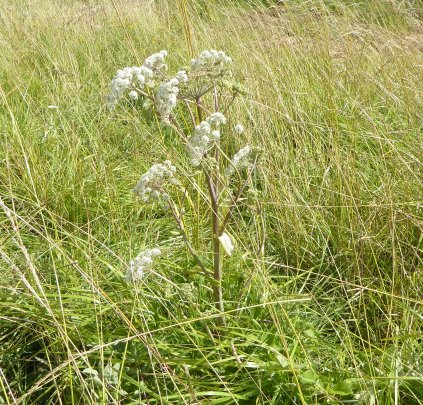
Whose idea was the
leaflet boxes on the gates? Excellent.

Gwynne Johnson's Rowan
plantation on the east side of the north meadow hosts
a large crop of bright red berries - good for the
local Blackbirds.

Hoary Ragwort
flowers are now opening on the orchid area and on
the Lumley area.
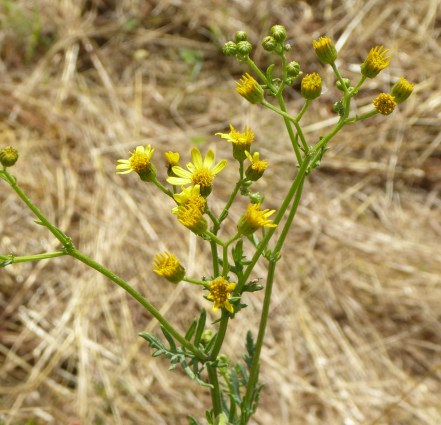
The Strawberry
Clover fruits are now ripening nicely on the path
on the east side of the Lumley area.
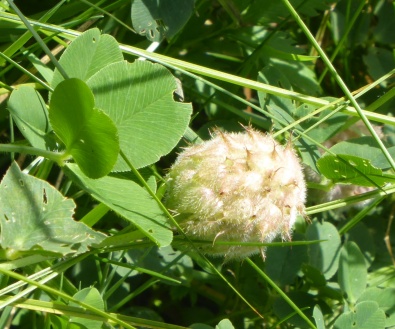
I had my first
flowering Amphibious Bistort of the year
climbing through the bank of Michaelmas Daisies on the
east side of the Lumley area. This plant is widespread
on the meadow, but rarely flowers. While looking the
Amphibious Bistort, I spotted several small flowers of
Michaelmas Daisies - also the first of the year
on Brook Meadow. Soon, this bank will be a mass of
flowers attracting late flying butterflies and bees.
The red berries of
Lords and Ladies attract attention near the
path through the south meadow.
The burrs are now showing well on the Branched
Bur-reed plants in the river north of the
S-bend
Branched Bur-reeds are
very extensive in the river and really need to be
cleared in the autumn to avoid blockages.
See video clip . . . https://youtu.be/WS5HaSfeI-Q
Slipper
Millpond
The Mute Swan
family with 3 cygnets were feeding together on Slipper
Millpond.

A Cormorant was a
first returnee to the centre raft. As winter
approached more Cormorants will arrive to feast on the
abundant fish in the pond.

A lady told me she had
seen a flock of Canada Geese on the pond a few days
and an unusual duck with a black head. There was no
sign of either today.
Testwood
Lakes
Highlights
from this morning's walk by the Havant Wildlife Group
around Testwood Lakes
Exuviae of two
large dragonfly were seen and 2 Wood
Sandpipers
Sand Martin nesting
wall with birds constantly flying in and out.
Derek managed a picture that clearly shows a brood of
3.
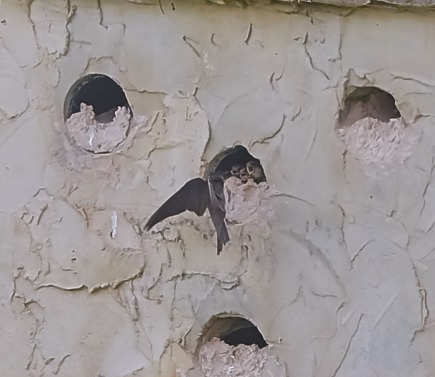
Ros pointed out the
Greater Birdsfoot trefoil and Flowering
Rush
For Heather's full
report go to . . . http://familyfellows.com/hwg-walk-reports-2018.htm
FRIDAY
JULY 27 - 2018
Tufted
Ducks
Christopher
Evans spotted a female Tufted Duck with five ducklings
on Langstone Mill Pond yesterday. Are they still about
and will they survive?

Green
Woodpeckers
Barrie Jay's
resident "Yaffles" have been quite productive this
year. Barrie got this cracking shot in the garden of
baby with dad!

News
from Cuba
Malcolm
Phillips had a new butterfly in his garden in Cuba
which he thought looked a bit like a Skipper but with
a swallow tail. He also had a bee which looks like a
standard Honey Bee.
Malcolm would like to
have some wildlife books to ID all these things, but
Barbie (his new wife) says the only place to get these
books would be in Havana about 10 hours drive away! Do
it on the internet Malcolm. E.g. www.butterfliesofcuba.com
I had a look for Malcolm's butterfly on this site, but
did not find it.
News
from Belarus
Peter
Milinets-Raby is in Belarus on a family holiday. He
reports:
"Swifts are doing very well here - the biggest
breeding concentrations I've encountered. Some great
birds seen have been seen within a 10 minute walk from
where we are staying. Two pairs of Red-backed Shrike
with young, a pair of Barred Warblers, a pair of
Wryneck and a plum tree that draws in up to three
Hawfinch at a time. Wonderful stuff. And, added to
this virtually every other house has a pair of Black
Redstart breeding. "
Peter sends photos of two butterflies. The one on the
left looks like some sort of Skipper. The one on the
right could be a Wood White which personally I
have never seen in this country (or elsewhere). It has
a very scattered distribution in England but is fairly
widespread in Ireland.
The plant has been
identified by John Norton as a Perennial Knawel
- rare in Britain and only in the Lakenheath area.
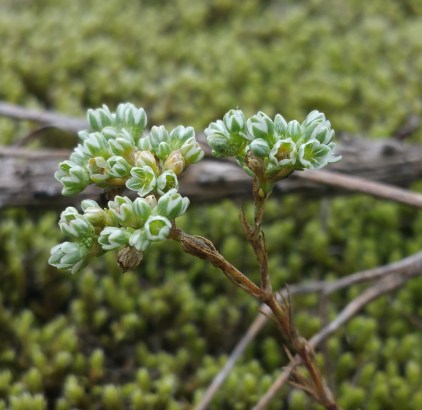
TUESDAY
JULY 24 - 2018
Ralph
Hollins tributes
I have
received the following tributes from members of the
Havant Wildlife Group to Ralph Hollins following his
announcement that he would be closing his wildlife
blog. My own tribute was on this blog for July 22.
. . . from Caroline
French
I would like to pass on my thanks to Ralph. Although I
wasn't there when the group was set up, I have
benefited hugely through its continued existence. I
really think the group was responsible for rekindling
my interest in birds. More importantly, through the
combined knowledge of those in the group, I was able
to broaden my interest and understanding to include
other taxanomic groups. The whole experience has been
and continuavg freees to be life-enhancing! So I am
extremely grateful to Ralph for setting up the group
all those years ago, sharing his vast knowledge and
enabling others to appreciate the wonders of the
natural world around us.
. . . from Fay
Durant
As one of the original members of Ralph's group ,
I'd like to say how much I appreciate being introduced
to the wonderful world of wild life by this
extraordinarily knowledgeable man . The fact our group
is still existing ,twenty three years after its
conception , says a great deal for the enthusiasm
Ralph instilled into us . He opened our eyes to the
world around us and encouraged us to observe and learn
. We owe so much to Ralph and offer him our sincere
thanks and wish him many more years of enjoying the
natural world.
. . . from Heather
Mills
We were indeed fortunate to have Ralph initiate
the beginning of a wildlife appreciation class in
1995. Many members have come and gone, but have
benefited from Ralph's dedication to freely impart his
fantastic knowledge on such a vast spectrum of natural
history. I am sure many who have met Ralph over these
23 years will join me in sending our very good wishes
for his continuing good health. Our sincere
thanks.
For full details of
Ralph's part in setting up this local wildlife study
group see . . . http://familyfellows.com/hwg-index.htm
MONDAY
JULY 23 - 2018
Brook
Meadow
I walked back
through Brook Meadow from an early morning appointment
at Emsworth Surgery before it got really hot. I
stopped briefly in Palmer's Road Car Park to admire
the fine display of Willow leaves hanging over
the car park, the pale grey ones of the White Willows
(left in photo) and the darker green of the nearby
Crack Willows (right in photo).
Walking through
Palmer's Road Copse was very cool!
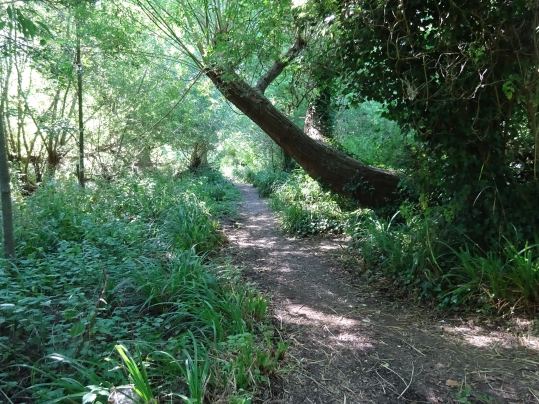
Speckled Wood
butterflies were chasing each other as usual. One
stopped, seemingly peeping at me over the top of a
leaf with its single-pupilled eyespot.

I was pleased to find
the first Enchanter's Nightshade flowers of the
year on the Brook Meadow site alongside the path
through Palmer's Road Copse. This common woodland
plant is a rarity on the meadow.

I met a couple of
visiting birdwatchers from Wolverhampton who were
impressed with the meadow. They helped themselves to
one of the Brook Meadow leaflets from the box on the
south gate. Incidentally, it is so good to see these
leaflet boxes back at each gate after a long
absence.

Emsworth Millpond is
currently covered in a carpet of pale green algae.
This algae also grows prolifically in the harbour and
this year's exceptional growth is no doubt prompted by
the very hot weather. "Blanket weed" is the
name given to various filamentous green algae
(seaweed) that grow abundantly in fresh or brackish
water. I think this one is Enteromorpha
compressa. It is described in the Collins
Pocket Guide to the Sea Shore p.221 and illustrated on
Plate XXVI.

Bat
Boxes
I went over to
Brook Meadow at 13.00 this afternoon to observe the
erection of 6 bat boxes in Lumley copse by 5
volunteers led by David Search. In photo - Maurice,
Dan, David, Terry, Colin, Phil.

David had previously
identified suitable trees in the middle of the copse.
They were not easy to get to through a jungle of trees
and shrubs with a wheelbarrow of tools, two ladders
and 6 heavy boxes to carry. Here is Phil carrying one
of the ladders.

The installation of
the boxes on the trees was done by David ably assisted
by the other volunteers. It required David to climb a
ladder and first hammer a nail into the tree from
which the boxes would be hung. It was a precarious
task, but well done all.

Video
clip of David climbing the ladder
. . .
https://youtu.be/D3mHqflzf3w
Video
clip of David installing the first
box . . .
https://youtu.be/kPUUbSdCDmg
Two types of bat boxes
were erected close together on the same tree. One is a
woodcrete bat box with two entrances, one at the rear
against the tree trunk and one at the front. Bats
often creep in by the rear entrance and leave by the
front. The other is a maternity roost box with plenty
of space inside for young bats to roost in.
Video
clip of David demonstrating the nursery
box . . .
https://youtu.be/eHW3r2wFgDI
Video
clip of David completing the erection of the first two
boxes . . .
https://youtu.be/4_irV3kaWU0
I had to leave after
the erection of the first two boxes, but the rest
stayed on to finish the job.
David's report on the
bat box installation with more photos will shortly
appear on the Brook Meadow web site
Go to . . . https://www.brookmeadow.org.uk/conservation-news/
SUNDAY
JULY 22 - 2018
Ralph
Hollins closes blog
Wednesday July
18th was the 87th birthday of Ralph Hollins. He says,
. . . "as a present to myself, I am ceasing to update
this blog". His final blog entry can be seen at the
usual place at . . . http://ralph-hollins.net/Diary.htm
Ralph has been writing
his daily wildlife diary (or 'blog') for at least 20
years and I have been an avid follower all that time.
In fact, I have copies of all Ralph's diary notes
since 1997 stored on my computer and have frequently
made good use of them for local sightings. Ralph's
meticulous recording of all aspects of wildlife, not
only his own observations, but those from other
sources too, has meant his web site has become a first
port of call for local naturalists.
On a personal note
Ralph has been a major inspiration in my own more
modest excursions into the field of wildlife recording
with this Emsworth wildlife blog of mine. Our
relationship has been very much teacher and pupil and
Ralph regularly checks my blog, offering comments,
criticisms and corrections, which I have always valued
and learned from. I hope these will continue even
though his own blog is ceasing.
I first met Ralph
through the Havant Wildlife Group which he set up in
1995 with meetings on Monday evenings and nature walks
on Saturday mornings, both run by him. In 1997 Ralph
retired from the group, but the group carried on under
their own steam and it is a testament to Ralph's
vision that the Saturday walks are still carrying on
20 years later. We all owe Ralph a deep debt of
gratitude for opening our eyes to this wonderful world
all around us.
I have deliberately
kept up a special page on my web site for the Havant
Wildlife Group (renamed Friends of Wildlife) and on it
there is a brief history of the group along with
reports of walks and lots of photos. Go to . . .
Havant
Wildlife Group
There are not many
photos of Ralph but here is one I particularly like of
him explaining some tricky plant identification to Ros
and Caroline during a Saturday morning walk in 2007.

Ralph has always been
keen to share his knowledge with others, to inspire
them to look and learn for themselves. I am
unashamedly a big Ralph Hollins fan and have a quote
of his on the index page of my own web site . . .
"Whatever your problems or mood let wildlife brighten
your day". That sums him up perfectly!
PS I am quite
happy to publish any other appreciations of Ralph's
web site and blog or anything else to do with the
great man.
From
Heather Mills
We were indeed
fortunate to have Ralph initiate the beginning of a
wildlife appreciation class in 1995. Many members have
come and gone, but have benefited from Ralph's
dedication to freely impart his fantastic knowledge on
such a vast spectrum of natural history. I am sure
many who have met Ralph over these 23 years will join
me in sending our very good wishes for his continuing
good health. Our sincere thanks.
Note: Heather now runs the group that was started by
Ralph
SATURDAY
JULY 21 - 2018
Brook
Meadow
I went for a
walk through the meadow this afternoon before dinner.
The meadow was looking great after the cut, with large
areas of stubble interspersed with uncut wild areas
which act as refuges. My attention was attracted by a
Wild Angelica flower head on which a Bumblebee was
busily feeding while ignoring several pairs of Red
Soldier Beetles indulging in their customary activity!
The white tail plus the two yellow bands round the
body indicates it is a worker Bombus
terrestris, one of the most common Bumblebees.

Here is a video clip I
took of the show . . . https://youtu.be/Td7EKv36wc0
Iping
Common
Heather Mills
reported on this morning's walk by the Havant Wildlife
Group. They had a cracking close view of Silver-washed
Fritillaries.
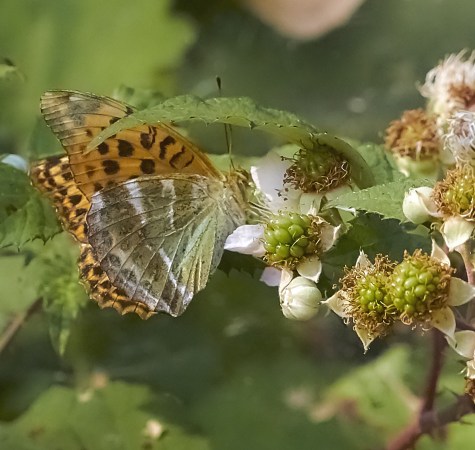
For the full report
and pics go to . . . http://familyfellows.com/hwg-walk-reports-2018.htm
News
from Cuba
Malcolm
Phillips sends his greetings from his new home in
Cuba. He and his new wife were sitting in the garden
today having a nice glass of wine when a Kestrel
appeared overhead hovered for a while then folded its
wings and dived down behind some trees. They did not
see if it caught anything, but what a cracking shot
from Malcolm.
This looks like a
Cuban Magpie Moth?
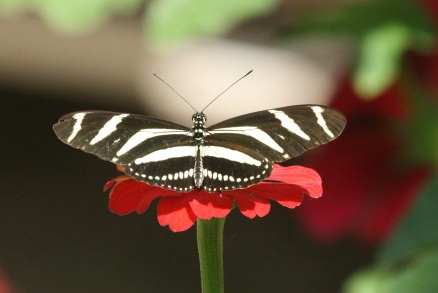
THURSDAY
JULY 19 - 2018
Brook
Meadow work session
I went over to
the meadow this morning to see the final day's annual
cut by Martin Cull. However, when I arrived I found a
group of volunteers assembled for the regular 3rd
Thursday in the month workday which I had forgotten
all about. Anyway, I joined in and took the group
photo as usual.

The main job was to
cut and clear the orchid area - now referred to as
'the flower rich area'. Maurice who was leading the
work session asked me to accompany Phil, who would be
doing the mowing with the power scythe, to help him to
avoid cutting the Hoary Ragwort, which had not yet
come into flower and which had Cinnabar caterpillars
feeding.

The rest of the group
raked and cleared the cuttings, though there's still a
lot left to do on the next work day.

Martin Cull finished
cutting the north meadow and generally tidied up
around the edges. A good job well done. See you next
year Martin.

Here is Martin taking
a coffee break with the group.
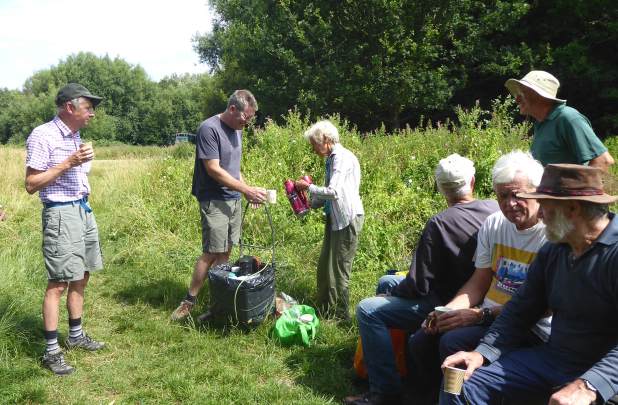
A full report on the
work session plus more photos can be seen on the Brook
Meadow web site
Go to . . . https://www.brookmeadow.org.uk/conservation-news/
Wildlife
observations
A family of
4 Carrion Crows, probably from a nest in
Palmer's Road Copse, were feeding on the stubble of
the mown centre meadow.

Quite a few
Cinnabar caterpillars were feeding on the Hoary
Ragwort on the orchid area, though none are yet in
flower. This is the reason why most of these plants
were avoided in the general clearance today.
Interestingly, I could not find any Cinnabars on the
Hoary Ragwort plants on the Lumley area.

I found the first
Marsh Woundwort flower spikes in the usual spot
in the north-east corner of the south meadow close to
the Weeping Willow tree. These attractive flowers
always arrive late and have to force their way through
a jungle of other vegetation.

I was pleased to find
a few fruits on the Strawberry Clover plants on
the path east of the Lumley area. So, we stall have
some despite their being inadvertently mown in early
summer.

WEDNESDAY
JULY 18 - 2018
Swifts
nesting
This hot
summer has clearly been much to the liking of Swifts.
We have had up to 11 flying around the houses in
Bridge Road Emsworth in the past week, but I have no
idea where they are nesting. However, this does not
apply to Mark Wagstaff who lives in Lee-on-Solent.
Mark has been trying for many years to get Swifts to
nest in his nest boxes and finally he has succeeded.
"After
20 years of trying (in the wrong place!) I contacted
some Swift experts about 5 years ago to ask how I
could attract Swifts to my nest boxes. I learnt they
need to be on a north facing wall (I had them facing
south!) and to use a CD with Swift attraction calls to
entice the birds to have a look at the boxes. This
worked almost instantly and for the last few years
we've enjoyed having Swifts nesting here - but only a
single pair. Thankfully they chose the one box I have
a camera in so I've been able to follow their progress
each year. A couple of years ago my neighbour asked me
to put some boxes up for her which I duly did and this
year it has all paid dividends.
To cut
a long story short - we both have 2 pairs of Swifts
nesting and on Monday night the BTO visited to ring
the young birds. We had 7 chicks between us to ring -
varying in age from about 2 weeks old to 4 weeks old.
They also managed to ring a single adult. My neighbour
is thrilled to bits with her Swifts and virtually the
whole street turned out to watch the ringers in action
so I might have requests for more boxes! After such a
slow start to the season (remember when the weather
was awful!) it's a pleasure to report on something so
positive. Might even be better next year!"
Mark supplied the
following information about how to obtain Swift boxes.
Let's hope his example will encourage other people to
get involved in helping these beautiful but seriously
threatened birds.
"The
boxes are made by John Stimpson - he has made
literally thousands in the last few years - they are
excellent and very reasonably priced. The only
addition I've made to them is to put a piece of (wide)
flashing on the roof, the sticky backed type (sold by
B+Q and other DIY stores in a roll) that I then firm
down on the wood and just staple in place to be sure
it won't move. The roof gets the worst of the weather
(even under the eaves) so I think the flashing just
gives it a bit of extra protection. That said, they
are made out of exterior ply so should be good for
many years on their own.
I
don't think John has a web site but here's a link to
the Swifts Conservation page (the same people who gave
me the excellent advice on where to site the boxes
etc) and just down the page are photos of the box and
John Stimpson's contact
details:
http://swift-conservation.org/Shopping!.htm
I
think they are currently about £14 each - postage
is a bit steep because of the weight/bulk - but a
small price to pay for hours and hours of enjoyment!
You can also purchase the swift calls CD from this
site and also the swift nest forms which I should
probably have mentioned earlier - these really help
get the swifts started.
TUESDAY
JULY 17 - 2018
Brook
Meadow
I had a walk
around the meadow this afternoon, much cooler than the
past few weeks.
Lesser Burdock flowers are opening up on the
Seagull Lane patch and attracting Bumblebees. I think
this one might be a Bombus lapidarius
worker, all black with a red tail and no sign of
yellow.

I watched two male
Demoiselle damselflies (probably Beautiful
Demoiselles) chasing each other for at least 5 minutes
at the north bend of the river. They were still at it
when I left. Was this a territorial dispute?
The first
Cinnabar caterpillar of the year on the Hoary
Ragwort on the orchid area.

A patch of
Bent-grass with 15cm long panicles on the east
edge of the Lumley area. The fact that the panicles
were closed up suggests they were Creeping Bent with
exceptionally long panicles, rather than Black
Bent-grass which has open panicles in flower. There is
a very good show of Square-stalked St John's-wort
in the same area. The path to the east of the
Lumley area is a glorious display of wild flowers.
I spotted a
Nursery-web spider (Pisaura
mirabilis) with its nursery web. I am not sure
what it is doing as I can't see any eggs and the
spider does not have an egg sac.
A Honey Bee was feeding on Common Fleabane with
deep orange pollen sacs, presumably from the Fleabane?
Just a few
Strawberry Clover plants appear to have
survived the inadvertent cutting of this path in early
summer.
I had a strange
call which I did not recognise coming from the
direction of the Lumley copse - a rich trill repeated
three times. Not any bird call I am familiar with. I
check on the Kookaburra but its call is quite
different. Maybe it was a dog whistle?
Hermitage
Millponds
I had a quick
look at the millponds. Passing Peter Pond I noticed
what I assume was a racing pigeon take a
breather on the edge of the pond. It had a green ring
on its left leg with the numbers 086 and more that I
could not see. It resembles the pigeon that Anne
Moodie photographed also on Peter Pond on June 30. It
looks a bit lost. If it is the same bird it will be
very late getting back to its home! Today's bird is on
the left and Anne's on right.
The Mute Swan
family with their 3 remaining cygnets was on
Slipper Millpond.

But there was no sign
of the Great Black-backed Gull family. All
three rafts were empty and they were not on the pond.
So, I assume they have flown, probably into the
harbour. Here is the north raft where I saw the two
chicks last time on July 12. So, this completes
another successful breeding year for these magnificent
gulls on Slipper Millpond where they have nested for
the past 7 years. See special web page for full
details . . . Great
Black-backed Gulls on Slipper Millpond
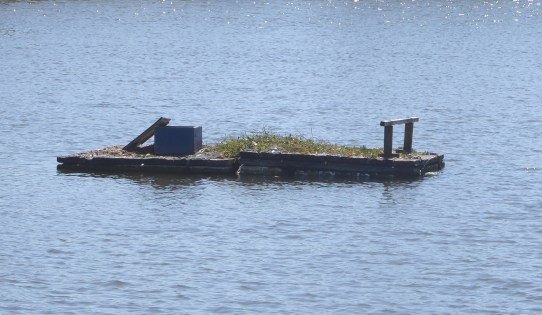
Langstone
Mill Pond
Peter
Milinets-Raby had a quick look at the Langstone Mill
Pond this afternoon from 1:44pm to 2:15pm - tide
nearly in.
Off shore on the last patch of mud were 7 Greenshank
and 11 Redshank - Amazing numbers for this time of
year!
On the pond were 44 Little Egrets, a female Tufted
Duck and a juvenile Grey Heron on the nest at the top
of the Holm Oak (A second brood sibling and certainly
the last bird of the season)
Cuckoos
crossing the desert
The BTO
reports that all 14 satellite-tagged Cuckoos have left
the UK and five have already reached Africa. Bowie,
Cameron, Selborne and Victor have even crossed the
Sahara and are now in the Sahel. The Sahel stretches
across Africa from the Atlantic Ocean to the Red Sea
and is a transition zone between the Saharan desert
and the wet climate of equatorial Africa. The dominant
feature of the climate of this region is the rainy
season, which occurs between July and September. The
Cuckoos will track the rains south from the Sahel,
moving down into their wintering areas in the Congo
towards the beginning of October. Check out the maps
to see where the Cuckoos are today. . . .
https://bto-enews.org/IG4-5R4G2-3RN36S-37JQVY-0/c.aspx
For
the previous entries go to . . . July
1-16